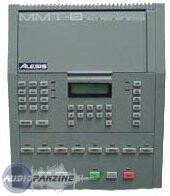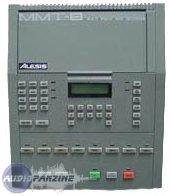View other reviews for this product:
Published on 04/19/07 at 20:01
Thru MIDI In Out, In Out Sync (to sync to a Portastudio for example), Click out, power in, footswitch start stop.
100 shares (of 694 black if desired), with each unit containing 8 tracks (these tracks will then have all the same length). In total, then 8 x 100 units possible.
99 song, the songs are a sequence of units.
16 channels on each of the eight tracks.
Edition not only not possible for FIX (can not enter the notes one by one).
Memory of 11,000 notes. K7 backups (no kidding!) Or SysEx dump (in both senses of the computer to the machine, the machine to the computer).
Today there is editing software MMT8Ex.exe paying only PC. Existence of several ROM (firmware) each with advantages / disadvantages.
For those who do not have the original adapter, do not worry: unlike inaccuracies read below, you can supply it with 9V DC (there is a diode-wave recovery, which allowed the Alesis 'AC power, cheaper at the time, photographs and drawings available mmt8.com). I personally use a universal power supply (what is typically found in supermarkets) adjusted by debiting 9V 500mA max and it works very well. (Put inside the + and - on the outside, otherwise no juice)
UTILIZATION
Use super simple once you understand the philosophy of the beast (enter button = red REC). Against by not undo. Everything is in front, very logical and basic (copy, dump, click, BPM, part song, edit, merge, etc ...)
Quantification in 1 / 64 only, very well for the binary electro (but quantization is disengaged).
16 channels per track possible merge between tracks as possible, with a little imagination you can make full use of the bike. Can duplicate a pattern on the same track, useful for increasing the beat juggling.
Setting the length of a black pattern in the hand of a black 680 and some.
Recording on the fly possible (drop in).
Twelve o'clock, or internal ext sync (with diffusion clock noon), and external sync via a magneto (obsolete today).
The manual is simple and clear. There is a memento in the cover MMT8.
Sequencer derived from that of HR16 (BAR) in the beginning, so if you like TR management pattern you will not be disappointed.
SOUNDS
Possibility of filtering: midi channel, DC, notes, aftertouch, SysEx, velocity.
Quantification assignale: 1 / 2, 4, 6, 8, 16 ... 64.
Muxage (merge) two tracks on one possible.
Warning NO UNDO!
Responsiveness of the keypad a bit long (must press the buttons)
The click is deactivated by a menu (no need to go fiddle with the inside of the bike as I read on some sites).
My advice: choose from such as banks (99!) And each track as a pattern (it still 16 channels). Use the merge to write her reasons.
OVERALL OPINION
Used for two months, the long-awaited tool to run patterns without having to use the external sequencer of my Machinedrum. It is used for sequencing of sentences recorded from my master keyboard to my destination KS Rack. Then I jam without keyboard triggering patterns from my or my Machinedrum MMT8. The only snag in mmt8, no external midi implementation, we can not control it from an external controller (at least it's not documented in the manual).
Today at 50 euros secondhand is a tool really handy and very cheap. He replaces Ableton Live, and allows me to be creative by its lack of visual interface (sound, just sound).
Another advantage is that it displays the result from the time beats, possibility to name the patterns in 16 alphanumeric characters.
Attention to memory management, especially if you tweak bcp. While thinking about dumper.
Lot of info (beware, in perspective, sometimes huge nonsense):
www.mmt8.com
100 shares (of 694 black if desired), with each unit containing 8 tracks (these tracks will then have all the same length). In total, then 8 x 100 units possible.
99 song, the songs are a sequence of units.
16 channels on each of the eight tracks.
Edition not only not possible for FIX (can not enter the notes one by one).
Memory of 11,000 notes. K7 backups (no kidding!) Or SysEx dump (in both senses of the computer to the machine, the machine to the computer).
Today there is editing software MMT8Ex.exe paying only PC. Existence of several ROM (firmware) each with advantages / disadvantages.
For those who do not have the original adapter, do not worry: unlike inaccuracies read below, you can supply it with 9V DC (there is a diode-wave recovery, which allowed the Alesis 'AC power, cheaper at the time, photographs and drawings available mmt8.com). I personally use a universal power supply (what is typically found in supermarkets) adjusted by debiting 9V 500mA max and it works very well. (Put inside the + and - on the outside, otherwise no juice)
UTILIZATION
Use super simple once you understand the philosophy of the beast (enter button = red REC). Against by not undo. Everything is in front, very logical and basic (copy, dump, click, BPM, part song, edit, merge, etc ...)
Quantification in 1 / 64 only, very well for the binary electro (but quantization is disengaged).
16 channels per track possible merge between tracks as possible, with a little imagination you can make full use of the bike. Can duplicate a pattern on the same track, useful for increasing the beat juggling.
Setting the length of a black pattern in the hand of a black 680 and some.
Recording on the fly possible (drop in).
Twelve o'clock, or internal ext sync (with diffusion clock noon), and external sync via a magneto (obsolete today).
The manual is simple and clear. There is a memento in the cover MMT8.
Sequencer derived from that of HR16 (BAR) in the beginning, so if you like TR management pattern you will not be disappointed.
SOUNDS
Possibility of filtering: midi channel, DC, notes, aftertouch, SysEx, velocity.
Quantification assignale: 1 / 2, 4, 6, 8, 16 ... 64.
Muxage (merge) two tracks on one possible.
Warning NO UNDO!
Responsiveness of the keypad a bit long (must press the buttons)
The click is deactivated by a menu (no need to go fiddle with the inside of the bike as I read on some sites).
My advice: choose from such as banks (99!) And each track as a pattern (it still 16 channels). Use the merge to write her reasons.
OVERALL OPINION
Used for two months, the long-awaited tool to run patterns without having to use the external sequencer of my Machinedrum. It is used for sequencing of sentences recorded from my master keyboard to my destination KS Rack. Then I jam without keyboard triggering patterns from my or my Machinedrum MMT8. The only snag in mmt8, no external midi implementation, we can not control it from an external controller (at least it's not documented in the manual).
Today at 50 euros secondhand is a tool really handy and very cheap. He replaces Ableton Live, and allows me to be creative by its lack of visual interface (sound, just sound).
Another advantage is that it displays the result from the time beats, possibility to name the patterns in 16 alphanumeric characters.
Attention to memory management, especially if you tweak bcp. While thinking about dumper.
Lot of info (beware, in perspective, sometimes huge nonsense):
www.mmt8.com



